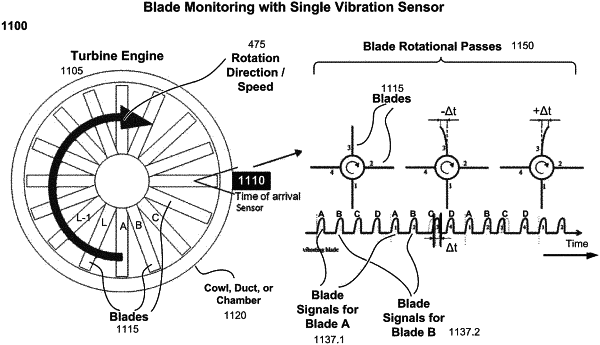| CPC B64F 5/60 (2017.01) [G01H 1/003 (2013.01); G01M 13/028 (2013.01); G07C 5/02 (2013.01)] | 20 Claims |

|
1. A method for obtaining mechanical state/property (MSP) data for a plurality of mechanical elements, each mechanical element (i) representing an individual rotating component and (ii) being engaged in a plurality of periodic rotations within a mechanical system, the method comprising:
generating, via a respective sensor of a plurality of MSP sensors, a respective time-continuous MSP sensor signal to be received at a processor, the respective time-continuous MSP sensor signal being representative of a plurality of periodic rotations of a respective one of the plurality of mechanical elements when the respective element rotates within a plurality of corresponding consecutive time windows;
wherein the plurality of periodic rotations are sensed via the plurality of MSP sensors being attached along a surface of each mechanical element, the plurality of MSP sensors being spaced apart from each other along a sensing path of the plurality of periodic rotations of each mechanical element;
for a first time-continuous mechanical data signal being a first respective time-continuous MSP signal from a first MSP sensor of the plurality of MSP sensors:
determining, via the processor, a first series of respective consecutive time windows when each respective mechanical element passes within a sensing range of the first MSP sensor;
determining a respective first plurality of time-separated gear data bins, each first time-separated gear data bin having vibration data associated with a plurality of periodic rotations of a respective one of the plurality of mechanical elements within the first series of respective consecutive time windows;
for a second time-continuous vibration signal being a second respective time-continuous MSP signal from a second MSP sensor of the plurality of MSP sensors:
determining, via the processor, a second series of respective consecutive time windows when each respective mechanical element passes within a sensing range of the second MSP sensor;
determining a respective second plurality of time-separated gear data bins each second time-separated gear data bin having vibration data associated with a plurality of periodic rotations of a respective one of the plurality of mechanical elements within the second series of respective consecutive time windows;
determining via the processor that a first gear data bin from the first plurality of time-separated gear data bins occurs over a first time interval t;
determining via the processor that a second gear data bin from the second plurality of time-separated gear data bins occurs over a second time interval t+1, wherein the second time interval is successive to the first time interval t; and
analyzing, via the processor, the vibration data from the first gear data bin and the second gear data bin, the analyzing generating a consolidated performance profile for each mechanical element, each performance profile (i) being generated by combining each of the first series of respective consecutive time windows and the second series of respective consecutive time windows that correspond to their respective mechanical element and (ii) containing data associated only with its respective mechanical element.
|